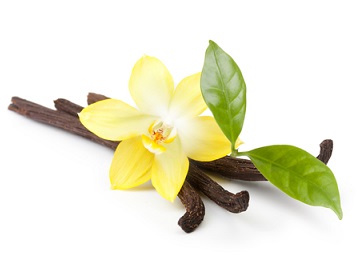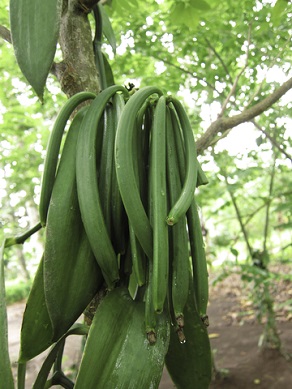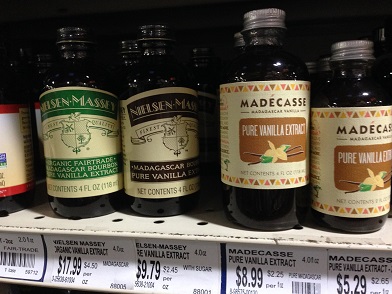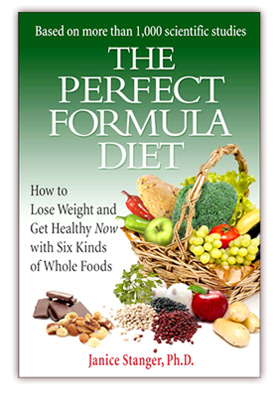
The vanilla flower is a gorgeous orchid, shown with the dried seed pods used for pure, natural vanilla spice
This Enticing, Aromatic Spice Protects Your Health In Five Ways
Vanilla has an image problem. The run-of-the-mill perception is that vanilla is a plain and boring choice. Once you learn about this extraordinary spice, your appreciation may change. In fact, vanilla is a rare, expensive, and health-enhancing flavor.
Vanilla is produced from the seeds of a tropical climbing orchid that grows as a vine. Native to Mexico, vanilla was used by the Aztecs in the chocolate drink of their royalty. The bees and hummingbirds that pollinate this orchid are confined to Mexico, so for centuries after this spice became popular around the world, cultivation was limited to its home country.
The discovery of a method to pollinate the vanilla flower by hand allowed for its cultivation in Madagascar and some other tropical locations. However, the vine is fussy about light and shade, drainage, elevation, and rainfall, so locations to grow high-quality vanilla are limited.
In addition, it takes three years from planting to first flowering of the vanilla orchid. Growers need to be super attentive, as each flower blooms for less than a day, and must be pollinated in that short timeframe, then left on the vines for nine months to ripen before the vanilla beans are ready to harvest.
The green, newly-picked beans must go through a multistep curing process to develop the rich flavors

The seed pods of the vanilla flower are green when harvested, and must go through a multi-step curing process for the spice to develop its complex taste and fragrance
and aromas of the spice, which is the product of the seeds in the cured pods. This process takes another six to eight months. The long, labor-intensive process to produce natural vanilla makes this the second most expensive spice in the world, second only to saffron.
The Health Benefits of Vanilla
At least 250 components of the seeds harmonize to produce the flavor, aroma, and health benefits of vanilla. The most important component is vanillin, which is said to be responsible for about a third of the flavor. However, the complexity of whole foods cannot be reduced to a single element.
While research on the health benefits of vanilla is in its infancy, here are five ways that vanilla is healthy that scientists and cooks have already demonstrated:
ONE. Vanilla adds a natural sweetness to food. By flavoring your food with vanilla, you can cut down on added sugar and not miss it.
TWO. Vanilla inhibits the growth of microbes. One way it does this is by keeping bacteria from communicating with each other, which they need to do in certain circumstances to proliferate.
THREE. Vanilla has been shown to protect DNA, even against the effects of ultraviolet radiation. This is a process that helps guard cells against malignancy.
FOUR. As an antioxidant, vanilla helps protect food from deteriorating , and is sometimes used as a natural food preservative. In cells, vanilla neutralizes free radicals that can cause serious damage.
FIVE. When you consider all the benefits above, it’s not surprising that vanilla is anti-inflammatory. Since the majority of chronic illnesses are rooted in and facilitated by inflammation, future research may show direct benefits of vanilla in protecting against such disease.
Enjoying Vanilla

Natural food stores and supermarkets carry many brands of vanilla extract, which is always made from vanilla seeds. Watch out for “vanilla flavoring,” which is not the same thing. High quality extract, however, is expensive!
Vanilla is traditionally used as a dessert ingredient. This spice can be added to foods as an extract or a powder. The extract, generally easy to find, is alcohol-based. However, the alcohol evaporates if the food is cooked, and generally only a teaspoon is used for most recipes.
To be most healthy, limit vanilla to plant-based recipes. You can use it in dairy-free versions of frozen desserts, pudding, yogurt, cookies, cakes, and muffins. Sweet treats should be eaten only occasionally.
Use natural vanilla to deepen the taste of unflavored plant milks. Looking at healthier whole foods, vanilla can enhance the flavors of whole grain pancakes and waffles, hot and cold cereals, smoothies, fruit bars, and fruit salads. There is no reason the complex notes of this spice should not be used to add a new taste to savory dishes – feel free to be creative and experiment.
Watch out for “vanilla flavoring.” This is usually just factory-made vanillin, one of hundreds of the flavors and beneficial elements of the whole vanilla bean. While real vanilla extract or powder is much more expensive, you need only a small amount for most recipes, so one bottle can last a long time. It’s worth the higher cost is it fits your budget for a special treat. The tantalizing, multidimensional, subtle taste and aroma of vanilla comes only from nature.
If you enjoyed this post, you may want to try out David Gabbe’s healthy chocolate shake recipe, that uses vanilla to enhance the flavor of chocolate (just like the Aztecs did).
Intrigued? Now you can use our Whole Foods Blog Finder to target informative, fun postings on whole foods, plant-based diets. Quick information at no cost!
Blog posting by Janice Stanger, Ph.D. Janice authored The Perfect Formula Diet: How to Lose Weight and Get Healthy Now With Six Kinds of Whole Foods, a nutrition book that includes herbs and spices as an important whole foods category. Janice enjoys experimenting to find new foods she can add vanilla extract to.
Tags: antioxidants, cancer, chocolate, healthy desserts, inflammation, nutrition facts, Perfect Formula Diet, Plant-based nutrition, spice, vanilla, vanilla extract, vanilla powder, whole foods plant-based diet, whole foods plant-based recipes




